Editor’s note: We’re grateful to Dr. Pearson for permission to reprint excerpts from “Reviving an Ancient Tradition of Human Development,” Chapter 2 of The Supreme Awakening, which is now available as an ebook for Kindle.
Many thousands of years ago in the Himalayas of India, a remarkable research program took place. It did not involve study of the outer world. These were inner explorers. Their laboratory was their own consciousness. Their apparatus was their own nervous systems, purified and refined to the utmost. Their aim was to discover and develop, entirely from within, the total potential of human consciousness.
These were the Vedic rishis or seers. Fathoming the depths of their own awareness, they discovered that the human mind has the capacity to settle into a state of perfect stillness, beyond all perceptions, thoughts, and feelings, while remaining perfectly alert and awake. Here, at the source of thought, the mind opens into an ocean of pure consciousness, a limitless sea of pure wakefulness.
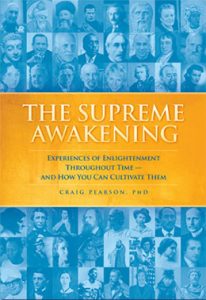
The Supreme Awakening is now available as an ebook on Kindle.
They discovered something extraordinary about this transcendental field: It lies beyond the boundaries not only of perception and thought but beyond individuality, time, and space. In the innermost depth of the mind lies the fundamental reality of nature itself, the all-pervading field of unity from which the infinite diversity of the universe is born. Everything in nature, from the flowers on the mountainsides to galaxies without end, arises from within this ocean of crystal clear consciousness.1
Vedic literature is the record of their experience. The word Veda means knowledge. It derives from the Sanskrit root vid, meaning to know, which has numerous linguistic cousins in English—wit, wise, wisdom, vision, vista, advise, evidence, idea, ideal.
Vedic wisdom flowed out from India in almost all directions, influencing language, literature, philosophy, law, and religion throughout Asia and, according to some scholars, throughout the world. Greek tradition holds that Pythagoras, Thales, Empedocles, Democritus, and others journeyed to India to study philosophy and that Indian sages visited Athens to share their knowledge…
The vast Vedic literature was preserved through the millennia as an oral tradition before being set down in books. But over centuries… Vedic literature became scattered, some elements of it all but forgotten.
The ancient Vedic rishis developed techniques for refining and purifying the human physiology so that it becomes capable of supporting the inner experience of transcendence. These techniques were handed down orally through innumerable generations, from teacher to student. But these too became distorted, the original procedures all but lost.
An American Awakening
Books from Vedic literature began to reach Europe in the late 1700s, where they influenced such European philosophers as Schopenhauer, Schelling, Hegel, and Fichte. Reaching England, they touched Wordsworth, Coleridge, Blake, and others. By the early 1800s, English translations of certain books were arriving in America.
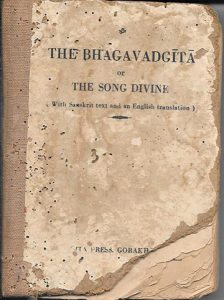
The cover of an early English translation of the Bhagavad Gita
When these works came into the hands of Ralph Waldo Emerson, they sparked a literary and philosophical movement that marked a new phase in American intellectual life and has influenced the entire nation ever since. For Emerson, as well as for Henry David Thoreau, and other prominent figures, the discovery of Vedic literature was as significant as Europe’s rediscovery, five centuries earlier, of the literature and culture of Greece and Rome—which gave birth to the Renaissance and marked the transition from the medieval world to the modern…
Thoreau’s celebrated experiment at Walden Pond, which reverberates in the world to this day, was inspired by these readings. He went to Walden Pond, Bhagavad Gita in hand, to commune not so much with nature as with himself—to gain enlightenment, such as he understood it from his reading.
Thoreau went to Walden Pond, Bhagavad Gita in hand, to commune not so much with nature as with himself—to gain enlightenment, such as he understood it from his reading.
The movement launched by Emerson and his compatriots came to be called American Transcendentalism. Vedic literature formed its life-breath…
Under the rubric of Indian philosophy, interest in Vedic literature has spread worldwide. But as Emerson, Thoreau, and others appreciated, the Vedic wisdom has less to do with philosophy than with experience. What they found illuminated in Vedic literature was a higher level of human development, a more exalted mode of being. They yearned to enter that world, to breathe that air, to live that reality—and as their writings indicate, they had momentary experiences of it. As Thoreau wrote to a friend, “To some extent, and at rare intervals, even I am a yogi.”2…
Maharishi Brings out a Simple, Effortless Technique

Maharishi Mahesh Yogi giving a lecture on the Transcendental Meditation technique, ca. 1959
In the second half of the 20th century, the most well-known teacher of Vedic knowledge was Maharishi Mahesh Yogi, the renowned scholar of the Vedic tradition and scientist of consciousness. From this ancient tradition he brought to light the core meditation technique, a simple, natural, effortless procedure to which he gave the modern name Transcendental Meditation. This technique became the most widely practiced and extensively validated technique for personal development.
From the mid-1950s forward, as people started learning this technique, they began having experiences like Wordsworth’s3 in increasing numbers. They were not poets or playwrights, not philosophers or monks. They were ordinary men and women from a wide diversity of backgrounds and cultures—in the United States, Europe, and around the world… Yet they were reporting experiences very much like those celebrated in the writings of Wordsworth, Plato, Thoreau, and many other figures across history.
Here is how one person describes the experience:
I distinctly recall the day of instruction [in the Transcendental Meditation® technique], my first clear experience of transcending. Following the instructions of the teacher, without knowing what to expect, I began to drift down into deeper and deeper levels of relaxation, as if I were sinking into my chair. Then for some time, perhaps a minute or a few minutes, I experienced a silent, inner state of no thoughts, just pure awareness and nothing else; then again I became aware of my surroundings. It left me with a deep sense of ease, inner renewal and happiness.4
Maharishi devoted his life to bringing the knowledge of the Vedic tradition to light in its original purity and completeness and to formulating it in terms consistent with the standards of modern science. After earning a university degree in physics, Maharishi spent 13 years studying and working with the great master of Vedic wisdom, Brahmananda Saraswati, who occupied the chief seat of Vedic learning in India and was widely revered as one of India’s foremost spiritual figures.
Maharishi devoted his life to bringing the knowledge of the Vedic tradition to light in its original purity and completeness and to formulating it in terms consistent with the standards of modern science.
Maharishi began teaching the Transcendental Meditation technique in India in 1955. In 1959 he traveled to the United States. Circling the world ten times over the next decade, he instructed tens of thousands of people, establishing teaching centers worldwide and training teachers of the technique. More than six million people have learned this simple meditation procedure, including two million in the United States—people of all ages, nationalities, and economic, cultural, and religious backgrounds. Several tens of thousands have received extensive training as teachers of the technique.
The First Stage of Enlightenment
Deep within everyone, Maharishi taught, is an ocean of pure consciousness, pure intelligence, pure bliss—the field of unity from which the diversity of the universe arises. Everyone has access to this inner reality of life. The key to raising life to its infinite potential is to experience and awaken this inner field. This, he asserted, is every human being’s birthright—and everyone’s essential need at this time of rapid change and rising stress.
Deep within everyone, Maharishi taught, is an ocean of pure consciousness, pure intelligence, pure bliss—the field of unity from which the diversity of the universe arises.
The Transcendental Meditation technique differs from most other procedures in that it involves no concentration or control. It is easy to learn and effortless to practice—so easy, even 10-year-old children can do it. It is practiced for 20 minutes twice a day while sitting comfortably with eyes closed. It is neither a philosophy nor a belief system; one need not even believe it will work.

Maharishi expounding on the TM technique, with two tulips, ca. 1959
This technique enables mental activity to settle inward, spontaneously and naturally. Maharishi called this process transcending, meaning going beyond. It culminates in a state of deep inner silence and peace, beyond thought—a state of pure consciousness, consciousness aware only of its own unbounded nature. At the same time, the body settles into a state of deep rest, enabling the body to dissolve accumulated stress and fatigue and to revitalize and rebalance itself.
This unique, restfully alert state, Maharishi contended, represents a fourth major state of consciousness, distinct from the familiar states of waking, dreaming, and deep sleep. In Vedic literature this experience is often termed samadhi. Maharishi called it Transcendental Consciousness and defined it as the first stage of enlightenment.
In Vedic literature the experience of a unique, restfully alert state is often termed samadhi. Maharishi called it Transcendental Consciousness and defined it as the first stage of enlightenment.
Scientific Research on Transcendental Consciousness
Experiences of exalted consciousness have been a topic of literary, philosophical, and religious interest throughout the centuries, as we have seen—but enlightenment had previously never been considered a subject of serious scientific inquiry. The term had a vague and perhaps mysterious connotation of some higher mode of being. Few scientists had considered an exotic, seemingly religious experience such as samadhi to be a proper subject of scientific study.

More than 380 peer-reviewed studies on the Transcendental Meditation technique have been published in medical and scientific journals, including 150 leading journals
But Maharishi vigorously encouraged scientific research on the Transcendental Meditation technique, even offering predictions as to what scientists might find. The first studies, conducted at UCLA in the late 1960s, found a surprisingly wide constellation of changes spontaneously occurring throughout the body during the practice—in breath and heart rate, in brain functioning, in blood biochemistry—all indicating a physiologic state of exceptionally deep rest. But unlike during sleep, the subjects remained fully awake.
Maharishi vigorously encouraged scientific research on the TM® technique, even offering predictions as to what scientists might find.
This combination of deep physiological rest coupled with full wakefulness, apparently a natural human capacity, had not been seen before in the laboratory. We are laid asleep in body, and become a living soul, as Wordsworth lyrically expressed it [in “Tintern Abbey”]. The scientists announced the discovery of a fourth state of consciousness.
The changes in brain functioning were particularly interesting. At the start of Transcendental Meditation practice, scientists discovered, the brain switches almost immediately from an essentially random style of functioning to an integrated state, reflected in coherent EEG patterns. This unique brainwave pattern indicates that the various parts of the brain are now operating synchronously, reflecting enhanced communication throughout the brain…
The scientists announced the discovery of a fourth state of consciousness.
Unfreezing Human Development and Higher Capacities
A second category of studies has detailed the cumulative effects of Transcendental Meditation practice. Regular transcending triggers a remarkable—and previously unsuspected—growth process, encompassing every area of life. The benefits, including increased intelligence and creativity, improved health, balanced personality development, and improved relationships, are often unprecedented. For example, intelligence (IQ) grows during childhood, then typically levels off in adolescence, around the same time physical growth plateaus, with a slow decline beginning around age 26. With regular experience of transcending, intelligence resumes growing, regardless of age, indicating that the “freezing” of growth in adolescence can be “unfrozen” and that human development need not stop.
With regular experience of transcending, intelligence resumes growing, regardless of age, indicating that the “freezing” of growth in adolescence can be “unfrozen” and that human development need not stop.
The same is true of moral maturity, field independence, and ego development, all of them profound measures of personal growth—all level off in adolescence, all resume their growth with regular Transcendental Meditation practice.5

The effects of TM practice go beyond relaxation and stress release, activating fundamental growth of higher human capacities
Human development levels off in adolescence, as shown in measures of intelligence, field independence, moral maturity, and ego development. Regular transcending through the Transcendental Meditation program expands consciousness, integrates brain functioning, and promotes human development even after it has plateaued.6
This large and growing body of research, encompassing every area of individual life, documents in ever-increasing detail the emergence of a fifth major state of consciousness, which Maharishi calls Cosmic Consciousness—the state in which the experience of infinite pure consciousness experienced during meditation becomes a permanently lived reality…
The Transcendental Meditation technique is widely appreciated as an effective means of reducing stress. But what we are seeing here goes far beyond relaxation and stress release. We are looking at a fundamental activation of human growth, especially of our higher human capacities. A technique with the ability to produce such a broad diversity of beneficial changes—in brain and body, mind and personality, in personal relationships and society as a whole—must operate at a very foundational level.7…
This large and growing body of research, encompassing every area of individual life, documents in ever-increasing detail the emergence of a fifth major state of consciousness, which Maharishi calls Cosmic Consciousness.
Maharishi compared regular experience of transcending to watering the root of a tree. Just as watering the root nourishes all parts of the tree in a single stroke, regular experience of Transcendental Consciousness nourishes all branches of life. The experience of transcending must activate some fundamental mechanism in mind and body that had previously been unknown in neuroscience, physiology, and psychology.
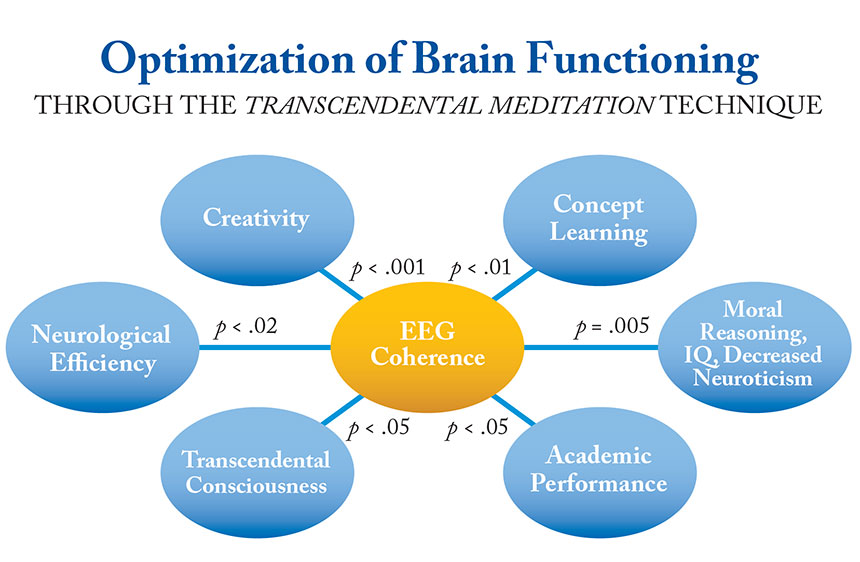
Optimization of Brain Functioning: Correlates of EEG coherence, from D.W. Orme-Johnson, C.T. Haynes, “EEG Phase Coherence, Pure Consciousness, Creativity, and TM-Sidhi Experiences,” International Journal of Neuroscience, 1981;13:211-7.
Early on, scientists realized that what they were studying was more than a meditation technique in itself. They were investigating a new possibility for human growth, involving previously unimagined improvements in mental, physiological, and emotional functioning.
Yet Transcendental Consciousness is a natural state. Everyone has the ability to experience it—every human brain is hard-wired with the potential to function coherently. Human beings are born not to suffer but to enjoy, Maharishi said—they need only develop their unbounded potential. The experience of transcending is the missing catalyst. And the Transcendental Meditation technique gives that experience effortlessly.
A Universal Knowledge
The core tenets of Vedic wisdom reverberate within all the world’s religious and wisdom traditions, particularly their mystical branches. These core principles have been referred to as the philosophia perennis or perennial philosophy, and the primordial tradition. These are its tenets:
- At the basis of the extraordinary diversity of the universe is a field of unity, sometimes termed the ground of being or the divine ground, in which everything has its being and apart from which nothing could exist.
- Human beings are capable of experiencing this underlying transcendental reality directly, deep within themselves.
- The purpose of life is to discover and experience this divine ground, to reconnect with the underlying essence of life. To do so is to realize one’s true nature, the eternal Self, and to transform and fulfill one’s life.8
This inner field is described everywhere in the world’s great philosophical and religious traditions. In the ancient Vedic literature it is called Atma. In Taoism it is referred to as the Tao, in Buddhism as Adibuddha, in Christianity as the kingdom of Heaven within, in Judaism as Ein Sof.
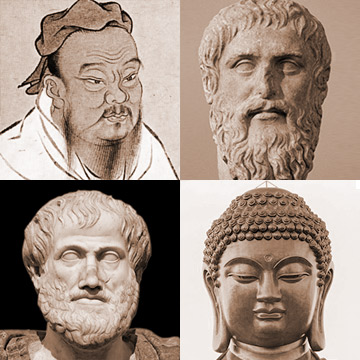
The inner field of human life is described in all the world’s great philosophical and religious traditions.
In ancient Greece, six centuries BCE, the pre-Socratic philosopher Anaximander named it apeiron — meaning the Boundless, the Unlimited. Two centuries later Plato referred to it as the Good, the One, and the Beautiful, while his student Aristotle called it Being. In the third century, the Egyptian-Roman philosopher Plotinus, like Plato, described it as the One, also the Infinite.
In 12th-century France, St. Bernard of Clairvaux termed it the Word. In 19th-century Germany, the philosopher Georg Wilhelm Friedrich Hegel called it the Absolute. In 19th-century America, Ralph Waldo Emerson called it the Oversoul. The 20th-century Swiss psychologist Carl Jung popularized the Latin term unus mundus (one world) to describe this underlying unity. For tribes in southern Africa it is Hunhu/ Ubuntu, for the Aborigines of Australia the Dreamtime.9
Today modern theoretical physics similarly describes a field of unity underlying nature’s diversity, called the unified field or the superstring field.
The terms vary, but they all refer to the same concept—the underlying field of unity from which creation springs. As the Rik Veda declares, “Truth is one; the wise call it by different names.”10
And at the core of many great spiritual traditions, we find the summons to look within and experience this field directly…
Across Traditions, the Summons to Go Within
One who knows others is intelligent.
One who knows himself is enlightened.
—Taoism | Laozi, Tao Te Ching | c. 600 BCE | China
Know thyself.
—Temple of Apollo at Delphi in Greece | c. 500 BCE
Be a lamp unto your own feet;
do not seek outside yourself.
—Buddhism | Gautama Buddha | c. 6th–4th century BCE | Nepal and India
What the superior man seeks, is in himself;
what the ordinary man seeks, is in others.
—Confucianism | Confucius | 551–479 BCE | China
Behold, the kingdom of God is within you.
—Christianity | Jesus Christ | c. 5 BCE–30 CE
Look within. Within is the fountain of good,
and it will ever bubble up, if thou wilt ever dig.
—Stoicism | Marcus Aurelius | 121–180 | Roman emperor
This region of truth is not to be investigated
as a thing external to us… It is within us.
—Neoplatonism | Plotinus | 205–270 | Egypt and Italy11
The Birthright of Everyone
Maharishi’s great work was to bring meditation and the concept of enlightenment into the mainstream, as well as into the arena of scientific research, vastly expanding the scope of scientific inquiry and the scientific understanding of human potential.
In the wake of the Transcendental Meditation program’s widespread success, many other procedures of meditation and personal development were put forward, some from Eastern traditions, some homegrown. As research began to be conducted on some of these as well, it became clear that different procedures produce different effects, notably in the resulting style of brain functioning. But the Transcendental Meditation technique is unique in a variety of respects—in its effortlessness, in the systematic experience of transcending it facilitates, in the integrated brain functioning and range of physiological changes that occur during the practice, and in the holistic growth that results.
The reality of transcendence and practices for transcending can be found at the inception of every religious tradition, Maharishi has pointed out, but they often became lost or obscured. Yet human beings are designed for enlightenment; it is everyone’s birthright. With the simple technique for transcending Maharishi brought to light, anyone and everyone can grow to enlightenment.
Maharishi’s great work was to bring meditation and the concept of enlightenment into the mainstream, as well as into the arena of scientific research, vastly expanding the scope of scientific inquiry and the scientific understanding of human potential.
To learn more about higher states of consciousness, visit EnjoyTM.org ►

Craig Pearson, Ph.D., is the author of The Supreme Awakening: Experiences of Enlightenment throughout Time—And How You Can Cultivate Them, and Vice President of Academic Affairs at Maharishi University of Management in Fairfield, Iowa.
To order a copy of The Supreme Awakening, click here ►
The Supreme Awakening is now available on Amazon for Kindle ►
In which the burthen of the mystery,
In which the heavy and the weary weight
Of all this unintelligible world,
Is lightened:—that serene and blessed mood,
In which the affections gently lead us on—
Until, the breath of this corporeal frame
And even the motion of our human blood
Almost suspended, we are laid asleep
In body, and become a living soul;
While with an eye made quiet by the power
Of harmony, and the deep power of joy,
We see into the life of things.
8. See, for example, Aldous Huxley, The Perennial Philosophy (London: Chatto & Windus, 1969). Also see Chapter 3, “The Seven States of Consciousness,” Note 3.


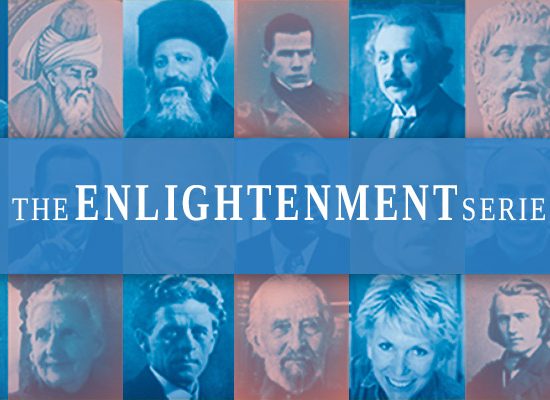



Wonderful! I’ve done TM for about 23 years, this year, and the inner experiences you have espoused correlate with what one experiences after meditation. With time one starts seeing that there is an inner state which is unchanging along with the ever-changing surface values of life! This helps develop a state in which you’re not unduly disturbed by the changing surface values! Thanks
Marvelous article! Thank you, Dr Pearson. I have been a teacher for 42 of my near 49 years of practicing TM. This article ties together things that I have often wondered about.
Thank you so much for this BRILLIANT and CONCISE explanation of TM and the Perennial Philosophy. Well done! Saving to my computer to share as needed!
(My parents owned a 1st edition of Huxley’s Perennial Philosophy, which I read as a college student. Luckily I learned TM a few years later in 1971. I still have the book, and, more importantly, still have my TM meditation.)